A quick look in the rearview mirror: no one. Clear road. At the head of the CMS race, WordPress dominates without competition.
At the end of the line, far, far behind, some competitors are fighting for the places of honor.

Among these challengers, we find Drupal. How does it compare to the champion WordPress? That’s what you’ll find out today in this Drupal vs WordPress comparison.
We compared the way both platforms work based on several criteria: ease of use, design, customization, SEO, security, price, etc.
By the end of this article, you’ll know exactly which CMS is best for your needs.
Overview
- Drupal vs WordPress: overview of the two CMS
- Ease of use and handling of the two CMS
- What types of sites can be created with WordPress and Drupal?
- Customization of both CMS
- SEO and performance on WordPress and Drupal
- Security and maintenance on both CMS
- Help and support on WordPress and Drupal
- Cost of the two CMS
- Drupal vs WordPress: which one should you choose?
Drupal vs WordPress: overview of the two CMS
WordPress and Drupal are two free, open-source CMS (Content Management System).
They are written in the PHP programming language and allow you to create any kind of website.
Open-source means that the source code is open: the user can freely access and modify it.
So much for their main points in common. Now let’s look at what makes them different.
Introduction to WordPress

Launched in 2003, WordPress is the number 1 CMS with 62.8% of market share, far ahead of its first competitor, Shopify (5.5% of market share at the time of writing).
Drupal has only 2.7% of market share.
Additionally, according to the very serious organization W3Techs, WordPress runs on nearly one website out of two in the world (43.3% in total) that use a CMS.
Even if its growth has slowed down a bit in the last few months, it remains the dominant CMS on the market.
When we talk about WordPress, we have to distinguish between WordPress.com (a hosting platform) and WordPress.org (the self-hosted solution used by WPMarmite, for example). We explain their differences here. For your information, we will only focus on WordPress.org in this article.
WordPress allows you to create any kind of website (showcase sites, online stores, blogs, etc.), whatever its size. Large companies trust it, including:
- The Walt Disney Company
- Forbes
- Renault
- Engie
- The Obama Foundation
Introduction to Drupal
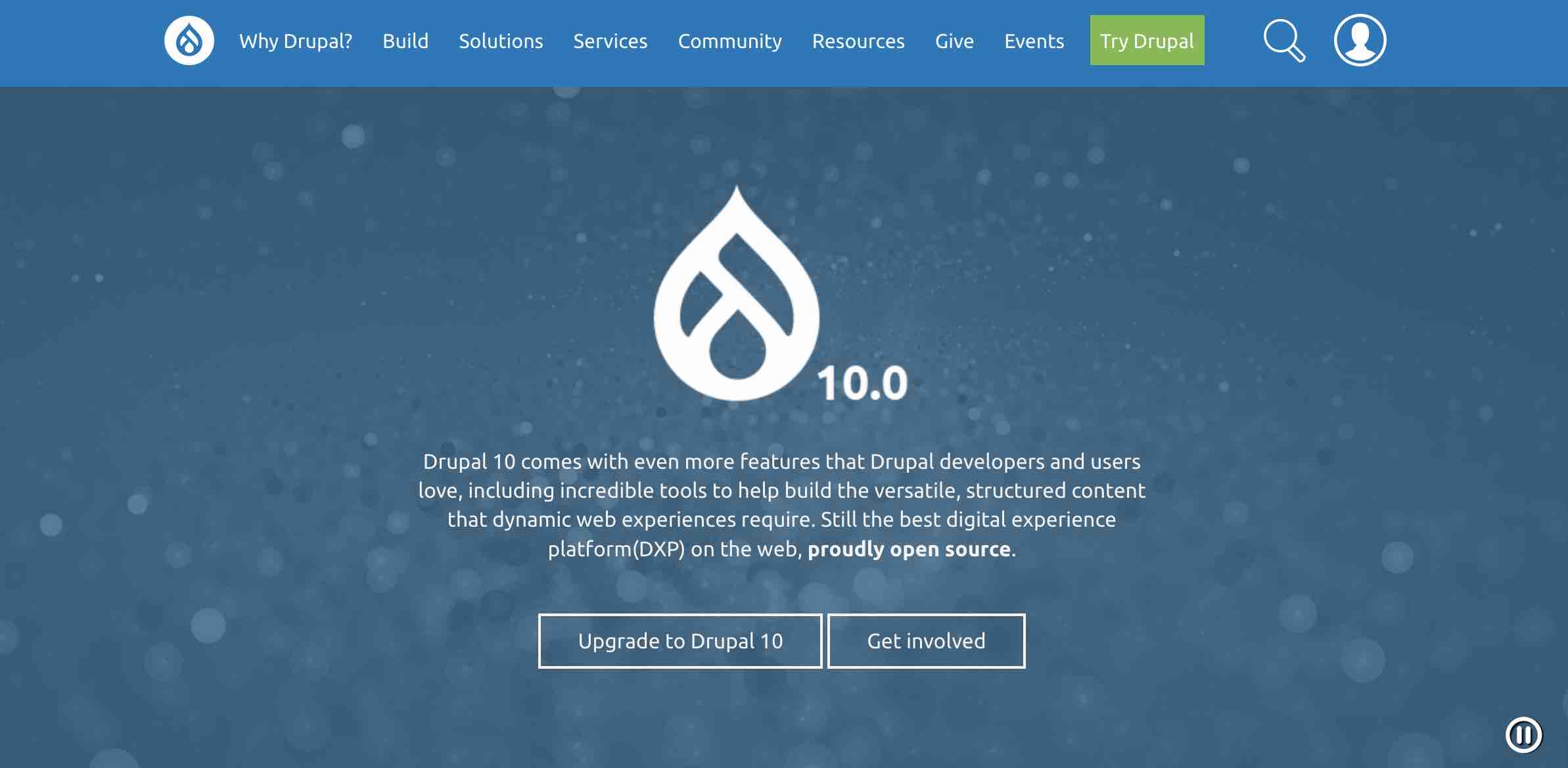
Drupal is a CMS created by the Belgian Dries Buytaert. Its first version dates back to January 2001 (the current version at the time of writing this update was Drupal 10).
Drupal is often considered as a CMS for developers and experienced technicians, even if Drupal’s website specifies that it’s also intended for “non-technical users.”
Like WordPress, Drupal is a CMS that’s flexible, modular, and quick to set up. It places a lot of importance — as does WordPress — on security, which is why many government agencies trust it. The USA government websites, for example, run on Drupal.
Drupal can be used to create the site of your choice. The list of famous brands that use it include:
- Tesla
- Pfizer
- grammy.com
- Princess Cruises
- The Economist
Finally, note that Drupal is in a downward trend in terms of its market share, which has dropped from 7.2% in 2013, to 1.8% in 2023:
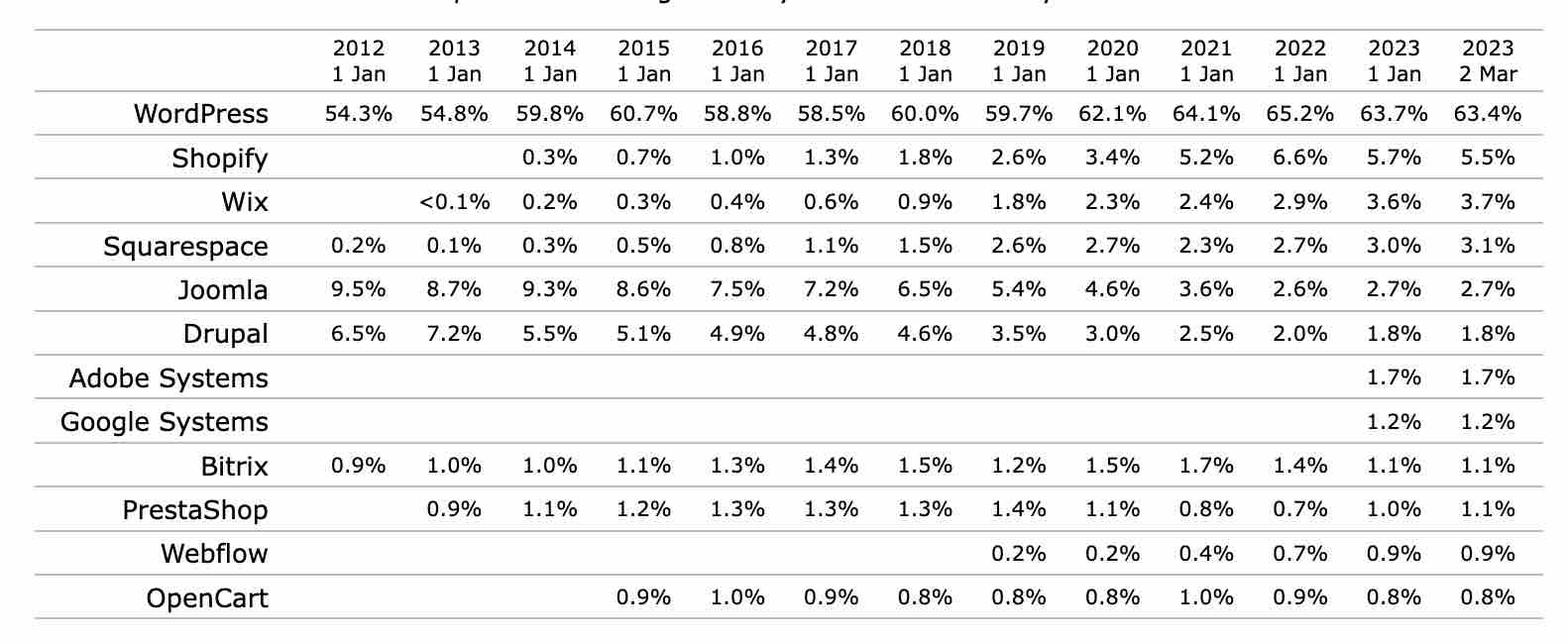
Ease of use and handling of the two CMS
Drupal vs WordPress: what is the difference in installation?
The manual installation process is the same for WordPress and Drupal. For both of them to work properly, there are several steps to follow:
- First, you must have a domain name and hosting.
- Then, you download the CMS software of your choice and upload your files to your online server.
- Finally, you link these files to a database.
If you opt for one-click installation, the set-up is the same: many hosting companies offer one-click automatic installation modules for both WordPress and Drupal.
In the end, it’s all the same: the difficulty is the same for installing WordPress or Drupal manually. Either one is doable for a beginner.
In practice, the installation is a bit longer with Drupal, partly because its native files are heavier than those of WordPress.
Want to install WordPress manually? Find out how to do it in this article.
Is WordPress easy to use?
The WordPress administration interface is quite clear. The left sidebar has links to the essential actions you can take, namely:
- Access to settings
- Managing users
- Creating articles and pages
- Adding media (photos, videos, and documents)
- Managing comments and customizing the visual appearance of your site
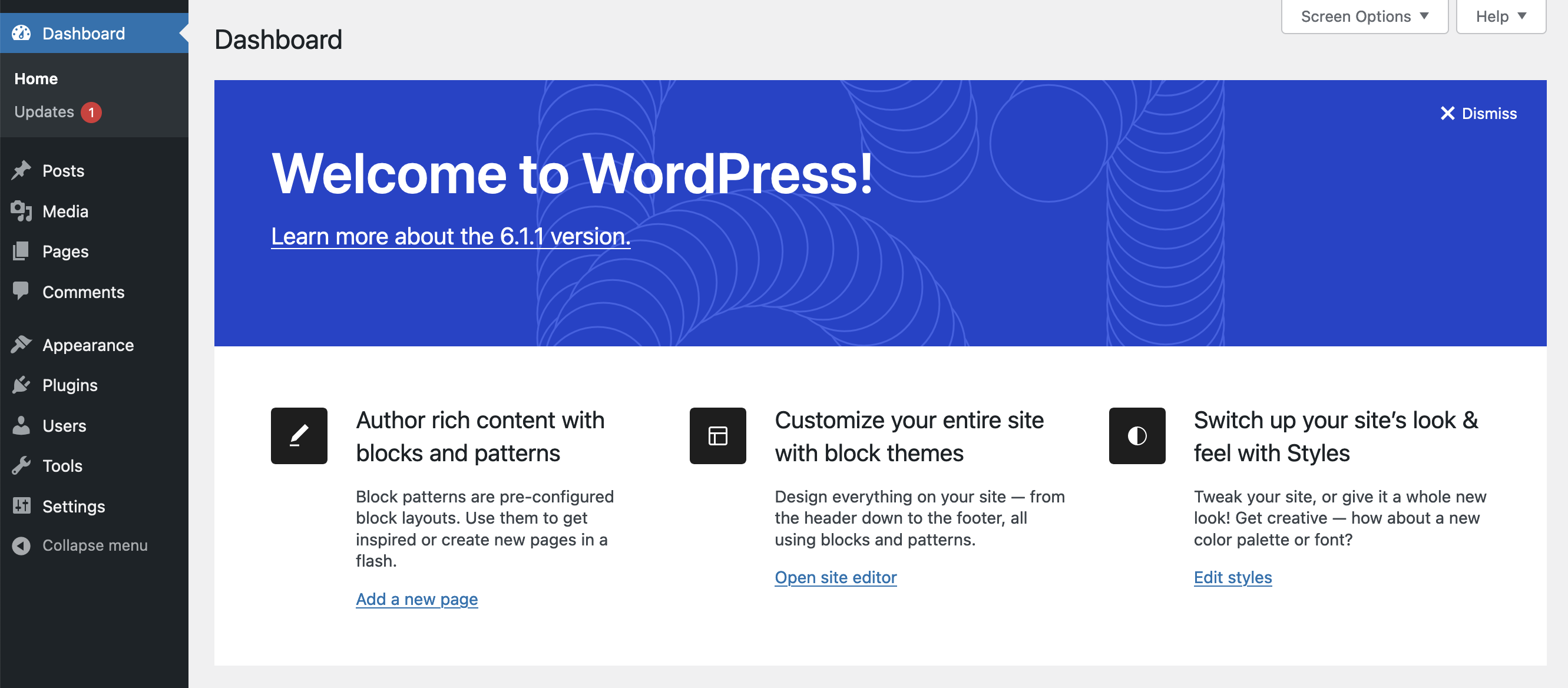
If you are a novice, you will appreciate:
- The flexibility of the content editor (Gutenberg). It allows you to add content visually, without coding, using ready-made blocks (containers). Writing a post or a page is as easy as using a word processor.
- The power of the Site Editor, which will help you create all the pages of your site, from the header to the footer, again without coding. However, a minimum of technical knowledge in web design and web development is required to take advantage of this tool.
- The fun side of the Customizer, available via the menu Appearance > Customize. Using this tool, you can modify the general appearance of your site (if your theme doesn’t need the Site Editor to work).
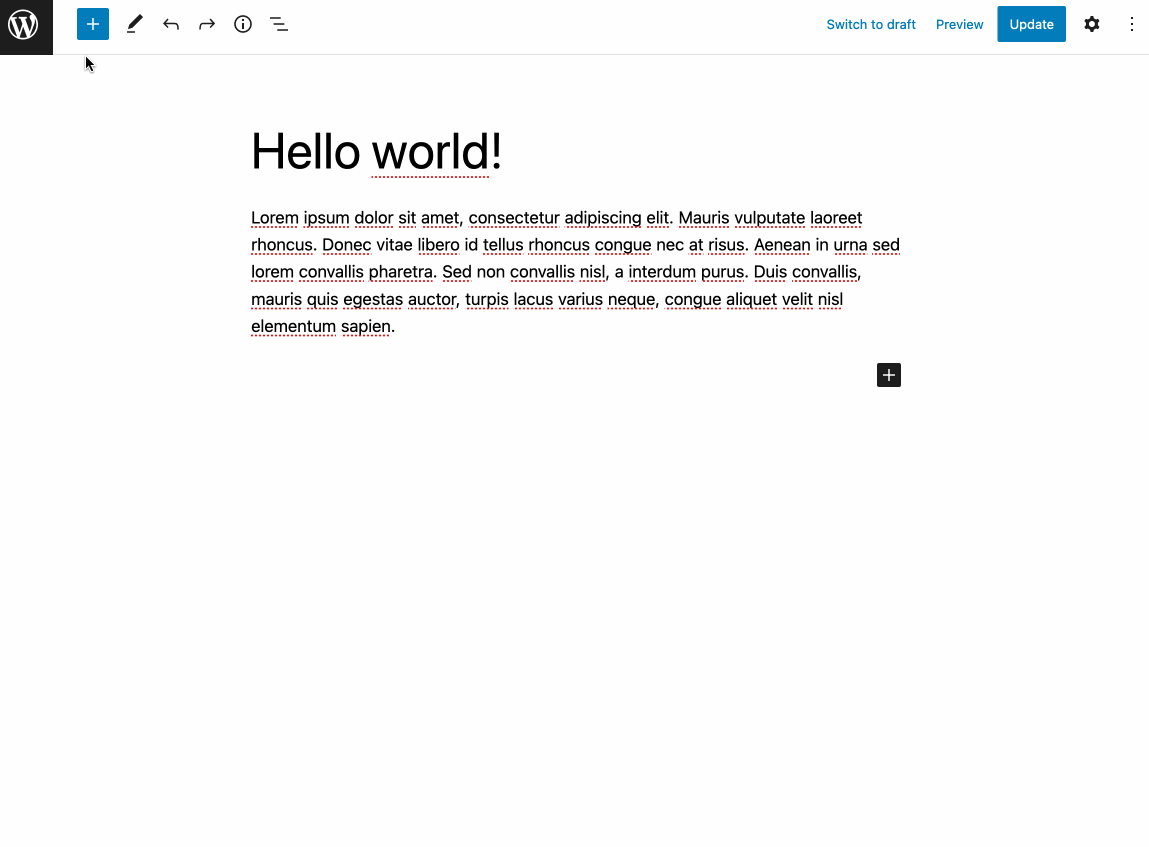
How to get started with Drupal
In Drupal, the dashboard looks old and a bit “retro”:
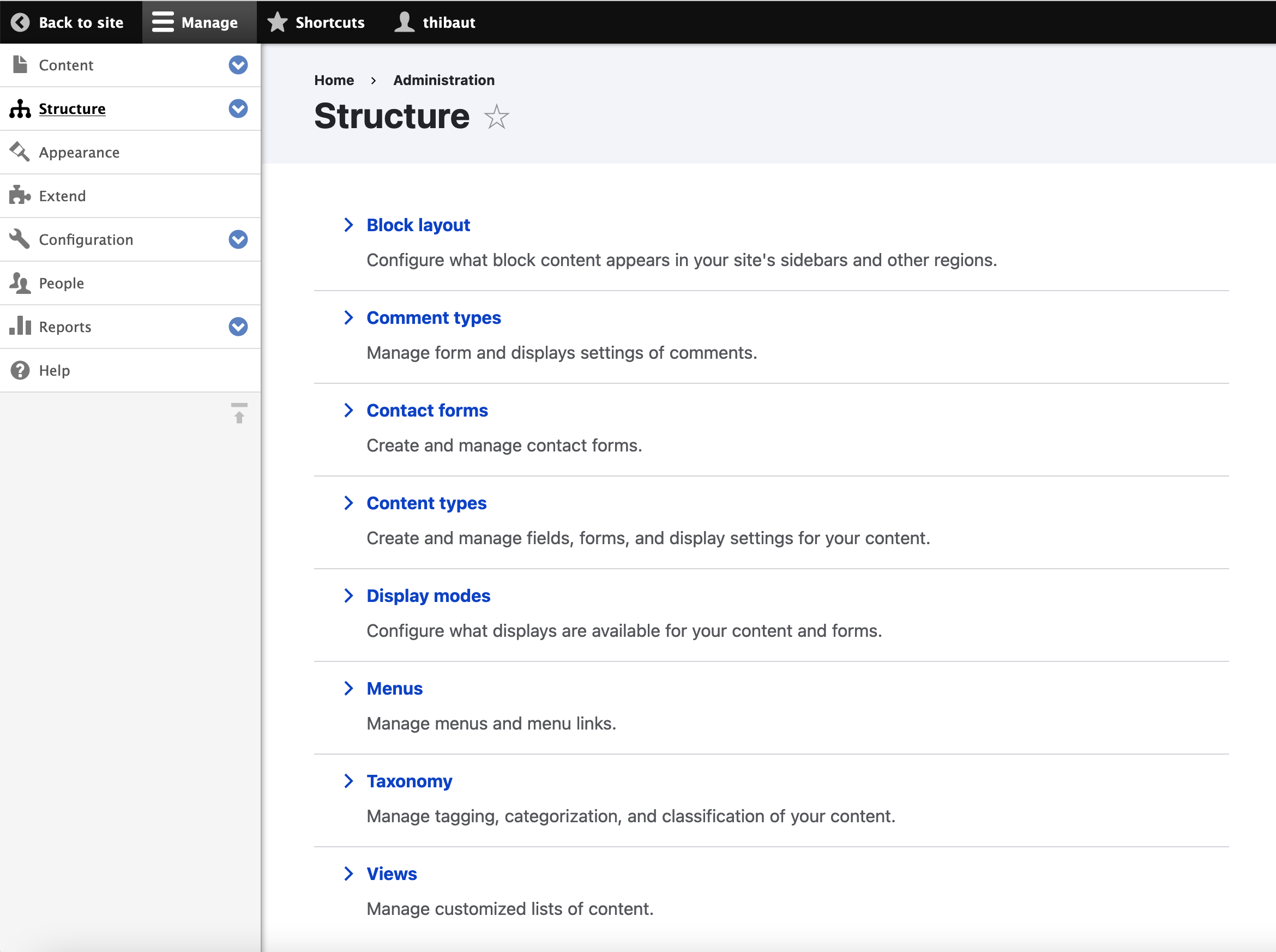
Let’s just say it’s not the most welcoming place for a user. From my point of view, the dashboard is messier than on WordPress, but you can still quickly access:
- Your content
- Its structure
- Your site’s appearance and configuration
- The users
And the winner is…?
More intuitive and more focused on the user experience, WordPress will be easier to use for a beginner and its learning curve will be shorter.
What types of sites can be created with WordPress and Drupal?
Both WordPress and Drupal allow you to design any type of site. To get a better idea, find out which one is more effective for creating a blog, an ecommerce site, or a multilingual site.
Creating a blog
Originally designed specifically as a tool for creating blogs, WordPress has a significant advantage in this respect as far as ease of content creation is concerned.
Its interface is also more readable, uncluttered, and intuitive than Drupal’s. It must be said that the WordPress content editor was designed to make life easier for beginners.
With Drupal, you can also create a blog. However, this CMS is much less intuitive when it comes to writing an article. Moreover, the content editor is quite limited in terms of options:
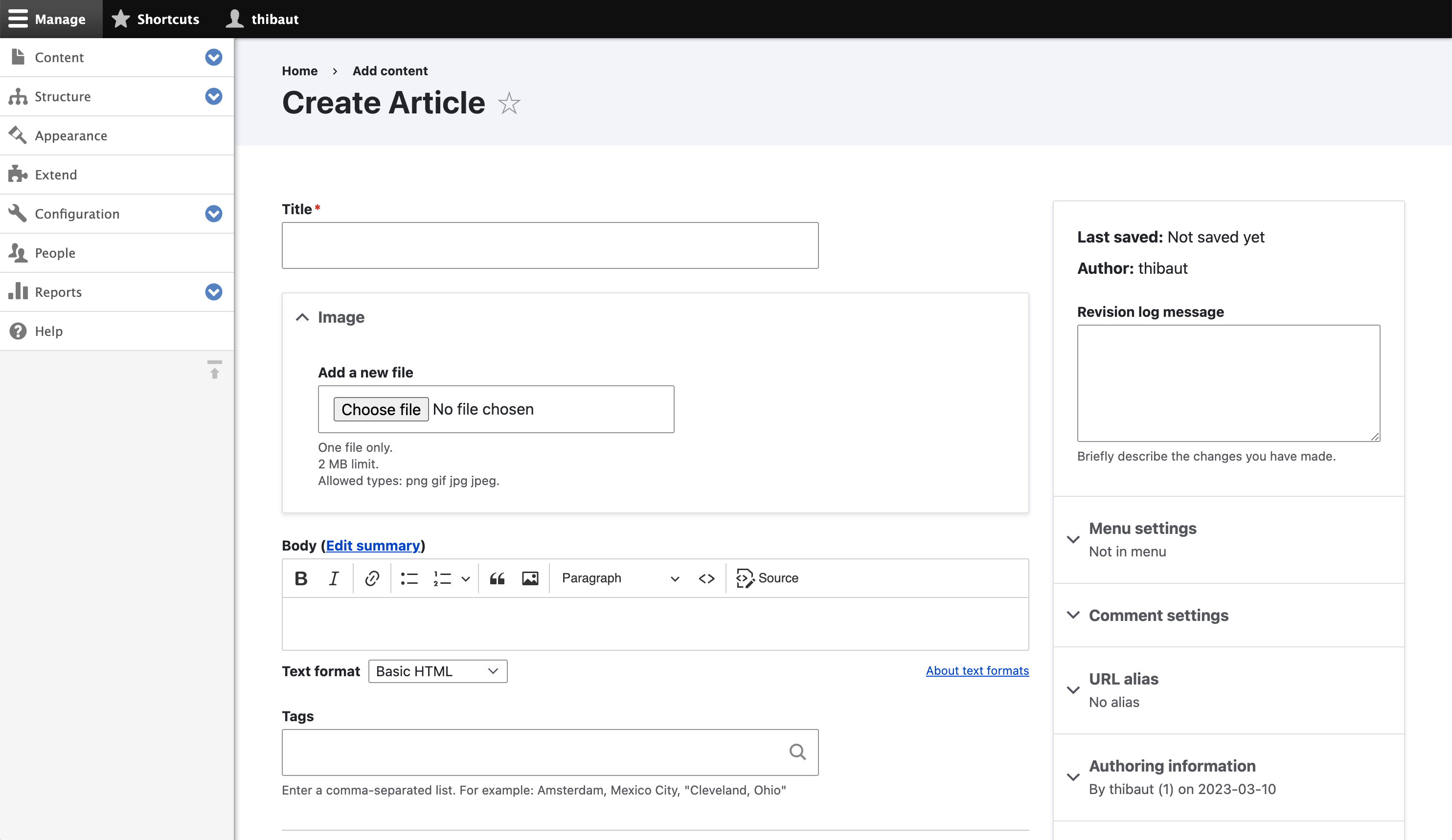
Create an ecommerce site
Natively, neither WordPress nor Drupal allow you to set up an online store. To do so, you must use a plugin or a dedicated module (a module is the equivalent of a WordPress plugin).
On Drupal, you can use Drupal Commerce or Ubercart. On WordPress, the most famous ecommerce plugin is called WooCommerce.
In addition, both platforms offer other plugins/modules to customize your store. In the end, it’s a draw for ecommerce in this Drupal vs WordPress confrontation.
Create a multilingual site
WordPress does not allow you to create content in multiple languages without a dedicated plugin or tool like Polylang, WPML, or Weglot.
The only thing you can do is to choose the language displayed on your administration (among a hundred, in Settings > General).
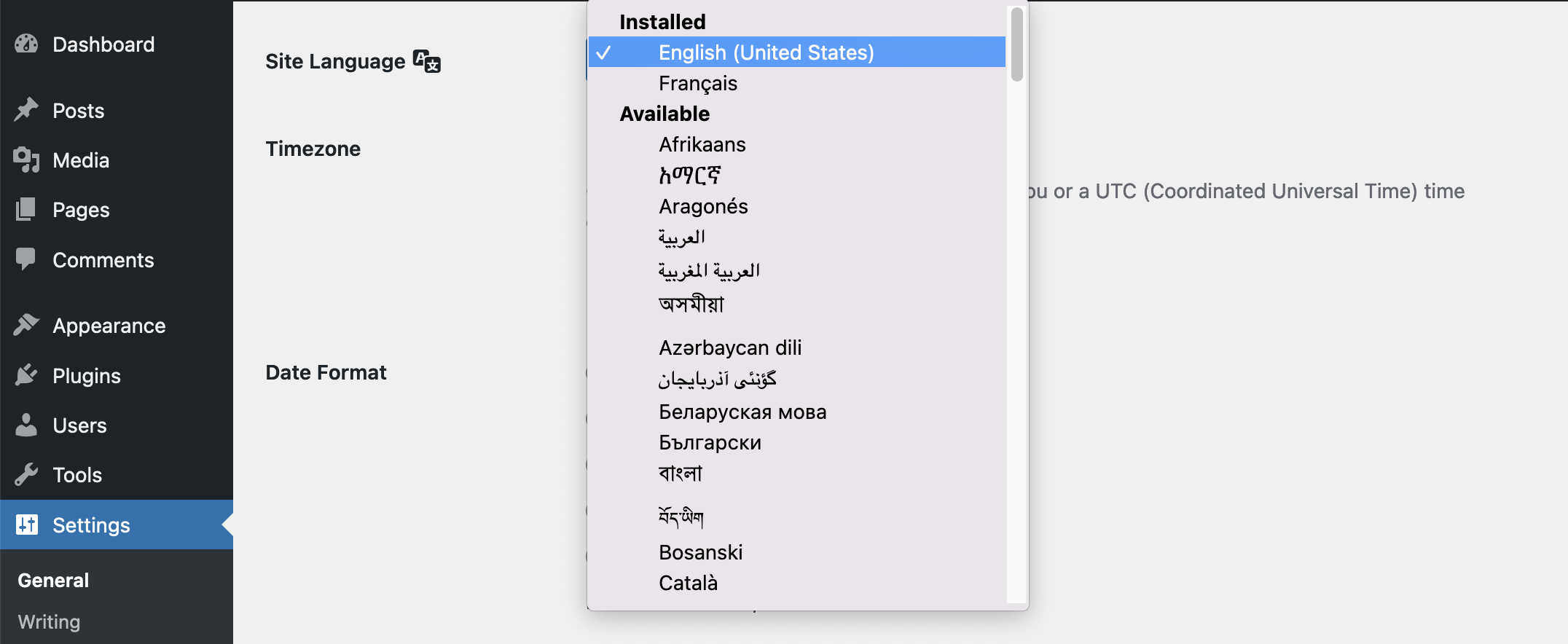
However, multilingualism is supposed to appear in the WordPress Core within a few months.
On Drupal, everything is managed natively without the need to use a module. For your information, this CMS offers a hundred languages by default. It is therefore more efficient than WordPress in terms of multilingualism.
To use this feature, you have to activate the multilingual modules in the “Extend” tab.
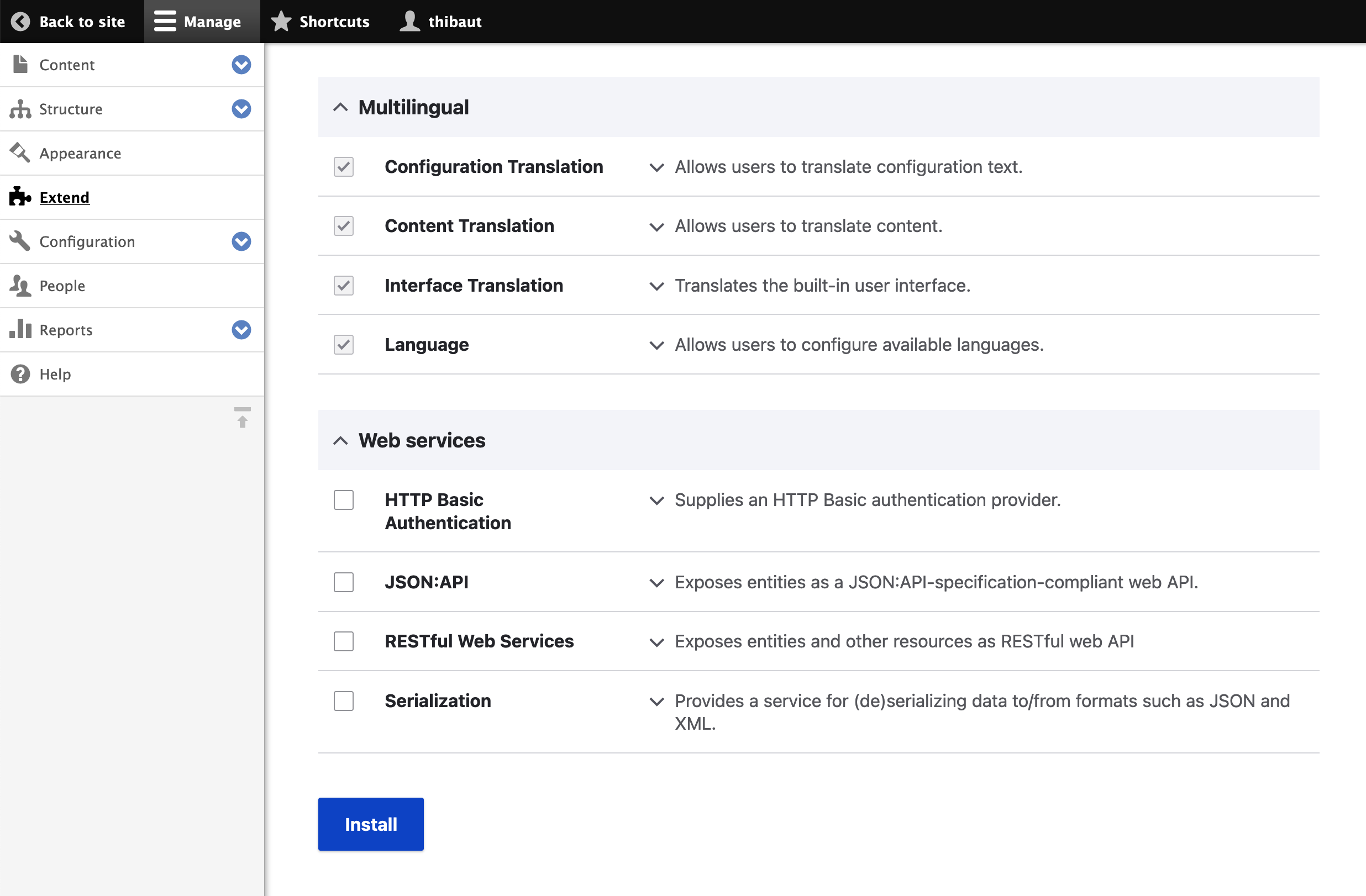
Once the language of your choice is added, you can activate it in two clicks.
You can then translate your strings and your content (posts and pages), as well as display a language selector on your site.
Customization of both CMS
Themes and plugins on WordPress
On WordPress, the design of your site is based on a theme. You can find a theme on:
- The official theme directory, which lists 12,146 (free)
- Specialized premium stores like WPZoom (affiliate link)
- Marketplaces like ThemeForest
To find the rare pearl among the many choices, check out our dedicated guide to WordPress themes.
To go even further in the customization and take advantage of WordPress’s flexibility, there are also what we call plugins.
A plugin is used to add new features to your WordPress site, without the need to code.
Just like for themes, you can find many options on the official plugins directory, which has more than 59,568 (free).

Check out our Top 25 must-have WordPress plugins.
To be even more exhaustive, there are also special plugins called page builders.
A page builder gives you the ability to design custom layouts thanks to ready-made templates, without needing to code.
Some of the most famous ones are Elementor, Divi Builder, and Beaver Builder.
Themes and modules on Drupal
Like WordPress, Drupal offers both themes and modules (the equivalent of plugins on WordPress) to its users.
However, the choice is much smaller than its competitor’s.
First of all, Drupal offers about 3,000 themes on its own official theme directory (free), at the time of writing.
However, only a hundred or so were compatible with Drupal version 10, the latest when we wrote this post.
For the most part, their design remains very classic, to put it nicely:
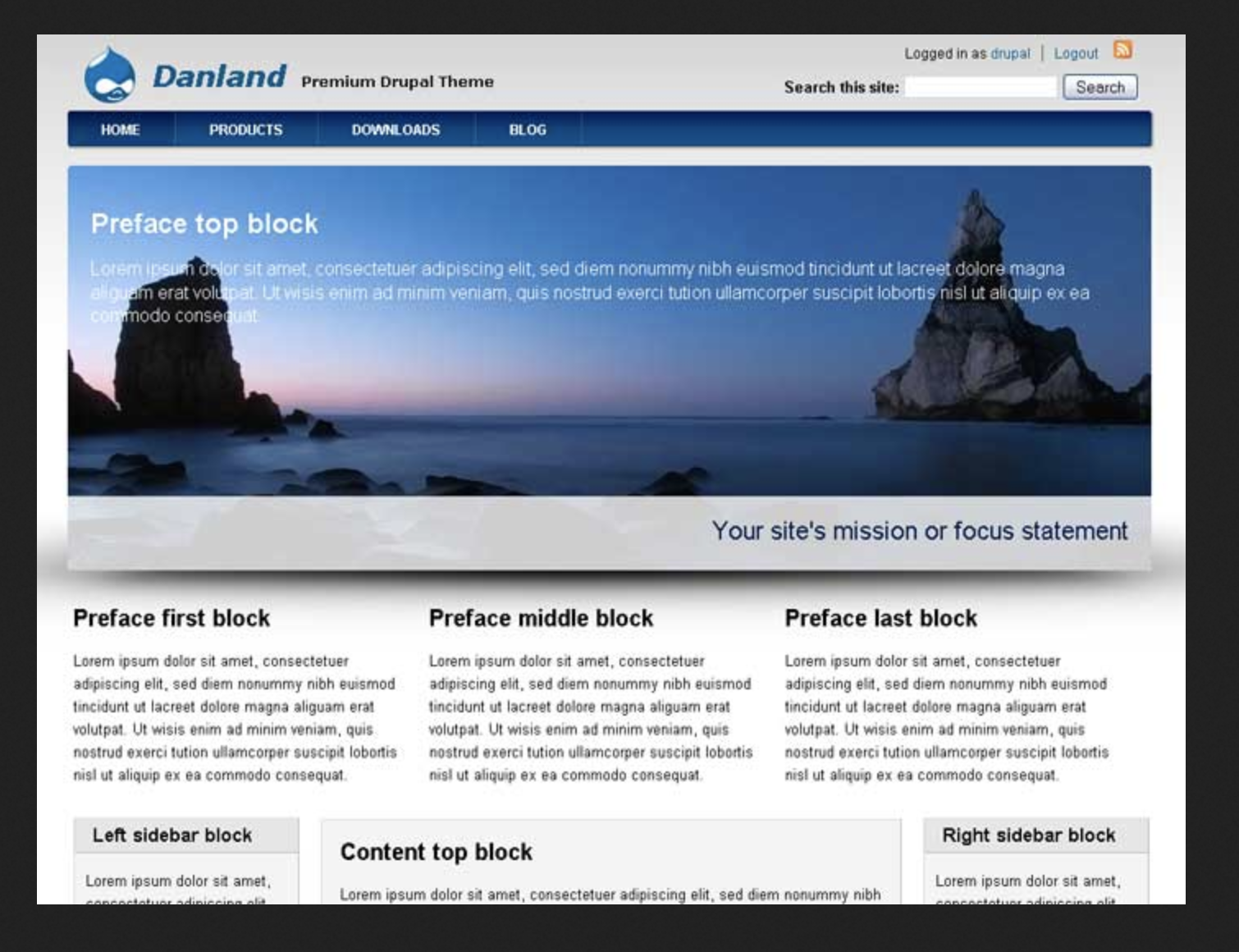
If you want more choice in terms of themes, you can turn to specialized premium platforms, like Themeforest, or to dedicated stores like Megadrupal.
Estimate about $50 on average to get a theme, which is about the same price range as on WordPress.
Now that we’ve discussed themes, let’s go to modules.
The choice is abundant on the official directory, with nearly 50,000 free Drupal modules in various fields: SEO, performance, security, content, etc.
Same situation as the themes: there are much fewer (about 4,000) that are compatible with the latest version of Drupal.
On the other hand, unlike WordPress where they are legion, there are very few paid Drupal modules. I found about 50 of them on Code Canyon, costing around $20 on average.
And the winner is…?
WordPress or Drupal? Drupal or WordPress? In my opinion, WordPress wins. It offers a bigger choice of themes and plugins, both in free and premium versions. And most of the time, their visual appearance is better (though of course you might change it to your liking later).
SEO and performance on WordPress and Drupal
A new round in this WordPress vs Drupal battle: SEO (Search Engine Optimization).
WordPress and SEO
WordPress is naturally optimized for SEO, although you’ll have to know and apply some good practices to avoid ruining everything.
The #1 CMS on the market lets you choose your permalinks (URLs), i.e. the address of your content.
For the rest, I recommend you to rely on a SEO plugin, though simply activating it will not be enough to propel you to the top of the search engine results.
On the other hand, it will allow you to optimize fundamental points such as Title and meta description tags, the implementation of a Robots.txt file, redirections, etc.
WPMarmite uses the most famous SEO plugin: Yoast SEO. Learn more about using it in this post.
When it comes to performance (page load speed), use a plugin like WP Rocket (affiliate link) to make your site faster.
Learn how to speed up WordPress in 10 steps with our dedicated resource.
Drupal and SEO
To optimize your SEO in Drupal, there are a lot of modules to create a sitemap, set up redirects, etc., just like with WordPress.
Don’t hesitate to use SEO checklist. This module offers you a list of best practices, as well as appropriate modules to install.
Another advantage of Drupal: it has a default caching system. You can set the caching parameters, empty it, and optimize external resources (CSS and JavaScript) to optimize the performance of the site:
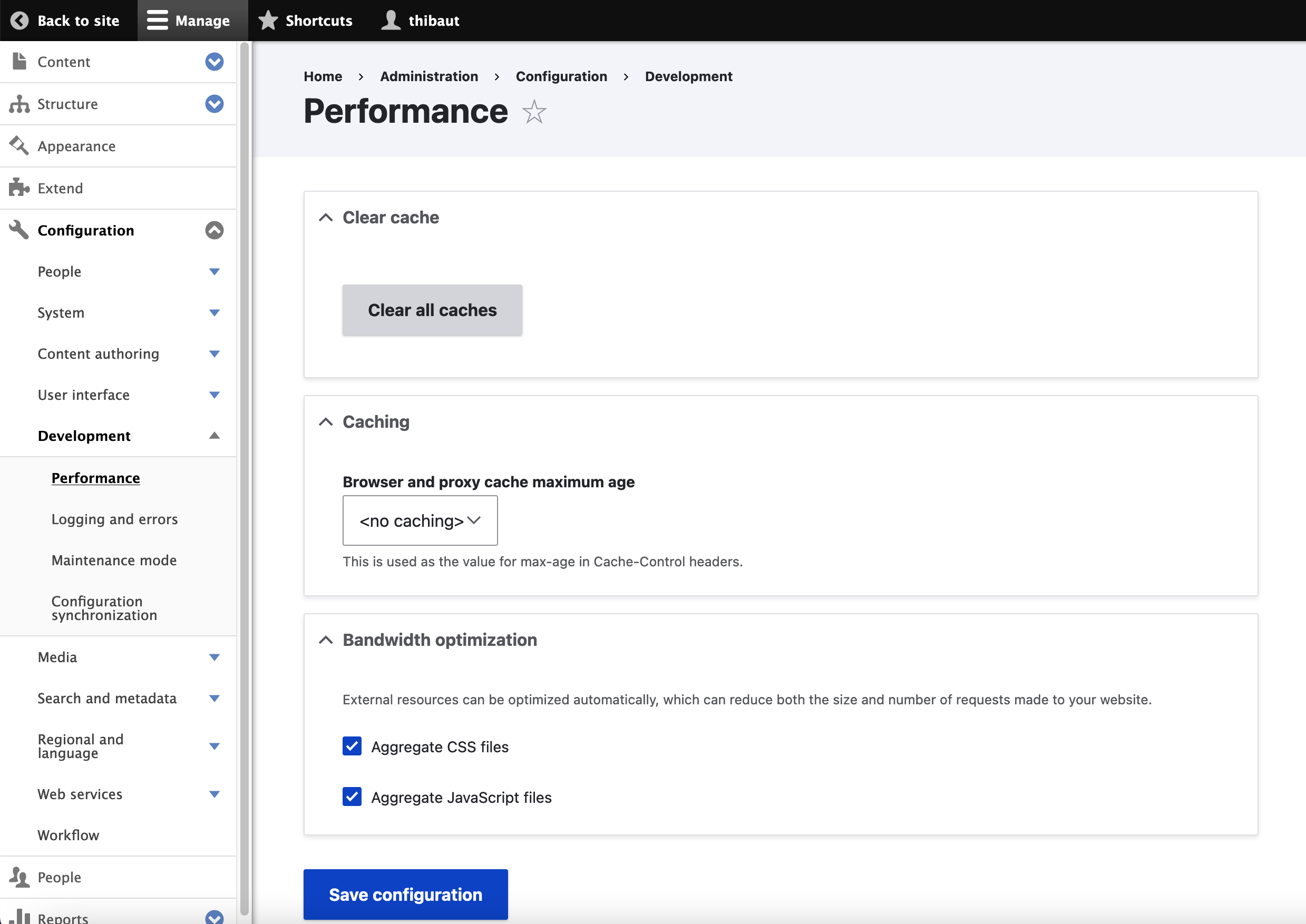
And the winner is…?
A tie. Both CMS can help you optimize your SEO thanks to many modules, but don’t stop at that to reach the top.
If you want to rank high in the search engine results, you will have to publish (good) content, which meets the expectations and needs of your users. But you also have to technically optimize your site, and especially get backlinks.
Our SEO guide explains all this in detail.
Security and maintenance on both CMS
Security on WordPress
As the most used CMS in the world, WordPress is naturally the target of many attacks. However, this doesn’t make it a CMS that’s open to all kinds of attacks.
The security expert Patchstack noted in a study that the WordPress core software contains only 0.58% of detected vulnerabilities.
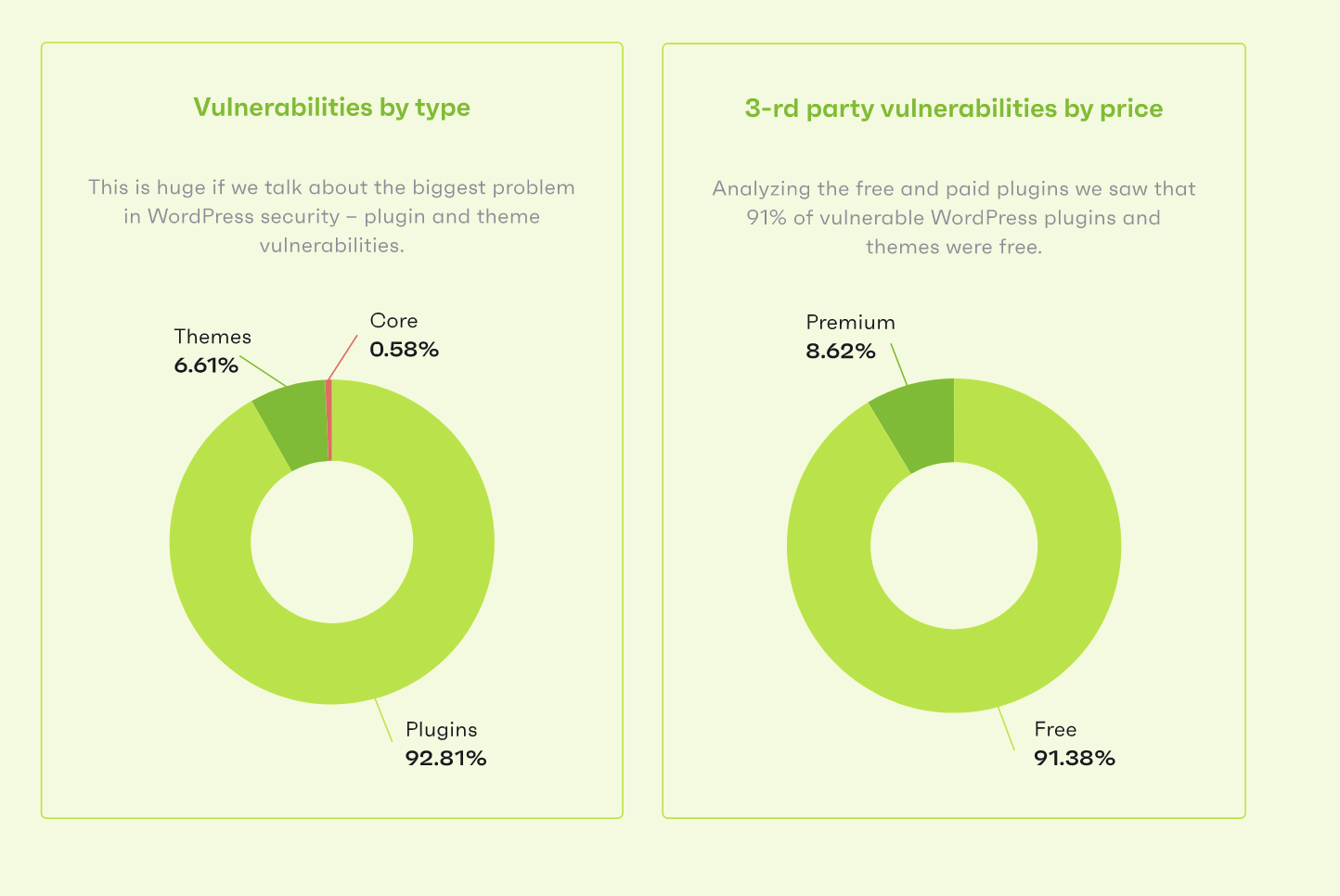
Most of the security issues come from vulnerabilities found within plugins and themes, but also:
- Inefficient maintenance by webmasters
- Poor configuration
- Lack of updates to WordPress sites
In case of a bug or crash of your site, see our guide to solving the main WordPress errors.
To further protect your site, use a security plugin such as SecuPress, iThemes Security, or Wordfence.
Security on Drupal
When it comes to security, Drupal is very popular. The number of governmental organizations that trust it is proof.
Like WordPress, Drupal takes security very seriously:
- It publishes security updates on average every 3rd Wednesday of the month, while communicating about possible security flaws on its official website
- It has an official Twitter account dedicated to security
- A dedicated security team is also in charge of checking all the plugins offered by the community developers (this is also the case on the official WordPress directory)
Moreover, as on WordPress with plugins, Drupal offers modules to strengthen the security of your site (e.g. Backup and Migrate, Login Security, and Security Kit).
And the winner is…?
On the security side, Drupal wins because it’s less vulnerable to attacks than WordPress, largely because it’s less popular: it attracts less attention. Moreover, it offers fewer third-party plugins, which are the source of a lot of attacks on WP.
On the other hand, as far as updates are concerned, there’s no advantage: WordPress is much easier to update.
Indeed, updating the Drupal core requires sending files directly to your server, which makes the process more complex.
Help and support on WordPress and Drupal
WordPress and Drupal offer many of the same resources to help their users find answers to their questions and to build their skills with their CMS.
Both tools offer, for example:
- Their official forum
- Official documentation
- Specialized groups on social networks
- Dedicated online resources (blogs, websites, etc.)
- Groups, meet-ups, and other events of all kinds (WordCamps for WordPress, Drupalcamps for Drupal)
And the winner is…?
So, the result of this round: Drupal or WordPress? The communities of both CMS are equally lively and dynamic and are organized in a fairly symmetrical way.
However, the WordPress community is much more developed, largely due to the popularity of WP.
Want to know more about other CMS on the market? Check out our comparison of Wix vs WordPress.
Cost of the two CMS
Two free CMS, but…
WordPress and Drupal are both open-source CMS. This means, among other things, that you can download their software as many times as you want, for free.
But beware, creating and maintaining a site on both platforms still has a cost. You will have to support:
- The costs related to hosting and domain name, whether you buy or renew. Count on average from $30 to $100 for the domain name + hosting combo.
- Costs related to a theme and premium plugins/modules, if you wish to use them.
Also think about the maintenance of the site, which at least has a cost in terms of time, if you take care of it yourself.
Finally, note that if you need to call for external help, for example for the development of a custom feature or the repair of a bug, the cost of a Drupal developer will probably be higher.
Drupal developers are more scarce, so prices are more expensive overall. The choice will be much wider on WordPress.

And the winner is…?
In terms of hosting, domain name, theme and premium plugins (or modules), WordPress and Drupal prices are similar.
Drupal vs WordPress: which one should you choose?
Here you are at the end of this WordPress vs Drupal comparison. As you have seen, both platforms have commonalities, their own unique features, and present both advantages and disadvantages.
WordPress: for whom?
WordPress is intended for any type of user and can meet all needs.
Beginners will appreciate its intuitiveness and flexibility, thanks to the presence of tens of thousands of plugins to customize your site/blog without coding.
All-terrain, WordPress will also delight more experienced users, who will be able to customize it in detail by getting their hands dirty.
I see WordPress as particularly suitable in two cases:
- If you are new to website creation and know absolutely nothing about code. The learning curve for WordPress will be much shorter than for Drupal, and its user interface is pleasanter and easier to use than that of its competitor.
- If you just want to set up a blog. WordPress is a tool that was originally designed to be a blogging platform. It’s in its blood!
Drupal: for whom?
Drupal is also very powerful, but much less suitable for a beginner. Less intuitive and harder to learn than WordPress, it is primarily intended for technicians and professionals in web development.
If you belong to this category of users, Drupal will be an excellent tool, especially if you need to create complex sites with a lot of content (though that is also possible with WordPress).
Versatile, scalable, and renowned for its security, Drupal is also suitable for businesses and public institutions.
Whatever CMS you choose, it’s possible to switch to the other option at any point if you realize that it better suits your needs. To migrate from Drupal to WordPress, use the FG Drupal to WordPress plugin. To switch from WordPress to Drupal, rely on the WordPress Migrate module.
Even if WPMarmite is a site dedicated to WordPress and I’m a WordPress fan myself, I tried to be as objective as possible to give you the most straightforward, accurate information. I hope it will help you.
So, WordPress or Drupal: which one do you use or will you use?
Tell me why by leaving a comment. And feel free to share your feedback with other readers.

Receive the next posts for free and access exclusive resources. More than 20,000 people have done it, why not you?







Continue reading
Articles posted in WordPress TutorialscPanel: Features and how to use this interface for your WordPress site
Need to modify the PHP version of your website? That’s where it happens. Need to create an email address? That’s where it happens too. Need to install an SSL certificate on short notice? Here again. Where? On your WordPress site’s…
How to redesign a WordPress website: the ultimate checklist
Aaah, the redesign of a WordPress website… When you think about the different issues that this mission involves, you usually tend to stress a bit. Who doesn’t dream, in this key moment, of doing a simple Command + Option +…
How to enable two-factor authentication on your WordPress site
A login + a password. Connecting to the WordPress administration interface is very simple, as long as you remember these two elements. From the point of view of the malicious person or robot that wants to access your site, it’s…